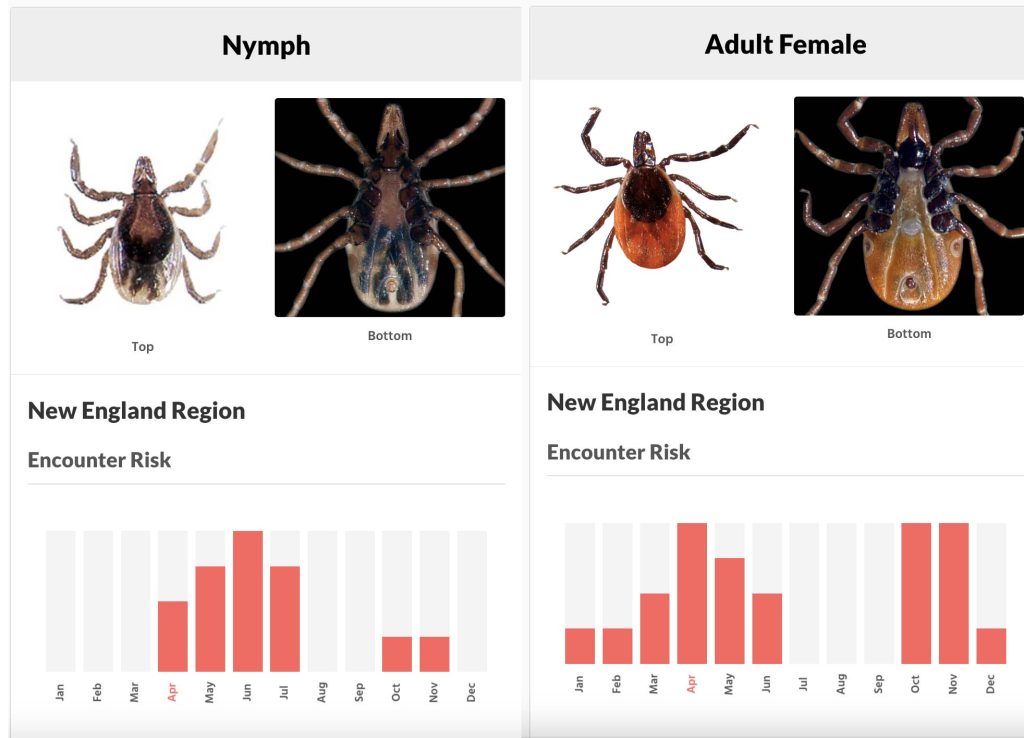Black-legged ticks carrying Lyme disease (and other diseases) are common in the Backlands. The more one knows about their life cycle, habitats, and personal tick bite-preventative measures, the better!
On This Page:
THE BASICS
LIFE CYCLE OF THE BLACK-LEGGED TICK
MORE ON PERSONAL MEASURES TO REDUCE LIKELIHOOD OF A TICK BITE
THE BASICS

NS Gov Poster
– Communicable Disease Prevention and Control – Tick Borne Diseases
Page on NS Gov website
“Tick populations are growing across Nova Scotia. The black legged tick, found throughout the province, is known to spread infections, such as Lyme Disease, Human Granulocytic Anaplasmosis (HGA), Babesiosis, and Powassan virus.
Blacklegged ticks survive best in areas that provide a moist habitat and are often found in and near wooded or forested areas, shrubs, long grass, leaf litter, urban parks, and gardens. Adult blacklegged ticks are most active in the spring and fall. They remain active until the temperature is consistently below 4°C. Larvae and nymphs are most active in the spring and summer…
Reduce the risk of having a tick bite:
– Use insect repellents safely. Read the product label carefully and follow directions on the package, it should state ‘for use against ticks’ on the product label. More information on approved insect repellents can be found here.
– Permethrin treated clothing repels and kills ticks when they come in contact with it and is registered for use in Canada for those 16 years of age and older.
– Wear light-colored, long-sleeved shirts and pants, closed toe shoes.
– Tuck shirts into pants and tuck pant legs into socks.
– Walk on well-traveled paths, avoiding high grass and vegetation.”
– Lyme Disease: What you need to know
CDC pamphlet (USA)
– Tick season is here. What to know about Lyme disease, anaplasmosis and more tick-borne illnesses
Chris Stoodley on yahoo news Apr 22, 2025 (Canada)
LIFE CYCLE OF THE BLACK-LEGGED TICK
CDC overview
U.S Center for Disease Control, 2024 doc.
“The lifecycle of Ixodes scapularis ticks generally lasts two years. During this time, they go through four life stages: egg, larva, nymph, and adult. After the eggs hatch, the ticks must have a blood meal at every stage to survive. Blacklegged ticks can feed from mammals, birds, reptiles, and amphibians. The ticks need a new host at each stage of their life.”

Source: CDC (USA) 2024 doc
Click on image for larger version
More details were available an older version of this CDC document (accessed 2019, no longer posted):
“Tick eggs are laid in the spring, and hatch as larvae in the summer. Larvae feed on mice, birds, and other small animals in the summer and early fall. The larvae may become infected with Lyme disease bacteria when feeding on these animals. Once a tick becomes infected, it stays infected for the rest of its life and can transmit the bacteria to other hosts.
“After this initial feeding, the larvae usually become inactive until the following spring, when they change into nymphs. Nymphs seek blood meals in order to fuel their growth into adults.
“Nymphs feed on small rodents, birds, and other small mammals in late spring and early summer. Nymphs will also feed on humans, and if previously infected with Lyme disease bacteria, they can transmit the disease to humans.
“Nymphs molt into adult ticks in the fall. In the fall and early spring, adult ticks feed and mate on large animals, such as deer. Adult female ticks will sometimes also feed on humans. In spring, adult female ticks lay their eggs on the ground, completing the 2-year life cycle.”
TickEncounter: Blacklegged (Deer) Tick
University of Rhode Island
“Overview: Blacklegged ticks (a.k.a deer ticks) take 2 years to complete their life cycle from eggs and larvae in one calendar year to nymphs and adults in the next. This tick is encountered predominately in deciduous forest as well as tall grasslands and shrubs bordering forest edges. Their distribution relies greatly on the distribution of their reproductive host, white-tailed deer. Both the poppy seed-sized nymph stage and the larger adult female stage are responsible for transmitting diseases such as Lyme disease, Babesiosis, and Anaplasmosis.”

Encounter Risk by month in New England for the two stages carrying Lyme (and other diseases) From Univ. of Rhode Island TickEncounter: Blacklegged (Deer) Tick
Click on image for larger version
MORE ON PERSONAL MEASURES TO REDUCE LIKELIHOOD OF A TICK BITE

I wear tick-repellant clothing when I figure on the basis of habitat, area and season that I could be highly exposed to lyme-carrying ticks. A few years back –circa 2017- when I made this pic and the comment “4 reasons for cross-border shopping” – this clothing was not available in Canada. It is now, e.g. at Marks, MEC – david p
Testing Mark’s permethrin-treated clothing
Brian Patton in the Canadian Rockies Trail Guide
Patton describes the difficulties in accessing permethrin-treated clothing in Canada as it was not permitted by the PMRA (Pesticide Management Review Agency) to be sold in Canada until in 2019 when “Mark’s suddenly released a line of permethrin-treated clothing under its WindRiver label”. Such clothing is now available at other sources as well, e.g. at MEC. There are still some PMRA restrictions on its use, e.g. it is registered only for those 16 years of age and older (as cited by NS Gov)
Says Patton, “I still…use repellent on exposed skin, face, neck, ears, and hands (Picaridin is my choice, but DEET and Oil of Lemon Eucalyptus are effective as well).
Commented Paton about the effectiveness of wearing the clothing plus use of repellent: ” there is no 100% guarantee that a tick can’t gain access to your flesh, and if it is a black-legged tick, transmit Lyme disease into your blood stream. But using well-designed, permethrin-treated clothing will improve your odds of travelling tick-free by about 95% (my educated estimate).”
Some studies on effectiveness of various personal preventative measures
– New study confirms efficacy of permethrin-treated clothing against tick bites
Infectious Disease News June 13, 2018 “…Results from the experiments showed that both laboratory-reared and field-collected ticks lost their ability to move after contact with permethrin-treated clothing and “posed no more than minimal risk of biting.”
– Personal protection measures to prevent tick bites in the United States: knowledge gaps, challenges, and opportunities
Lars Eisen in Ticks and Tick-borne Diseases Volume 13, Issue 4, July 2022. View Authors PDF for complete text. “Personal protection measures to prevent human tick encounters from resulting in bites are widely recommended as the first line of defense against health impacts associated with ticks.This includes using repellents, wearing untreated or permethrin-treated protective clothing, and conducting tick checks after coming inside, aided by removing outdoor clothing articles and running them in a dryer on high heat (to kill undetected ticks) and taking a shower/bath (to aid in detecting ticks on the skin). These measures have the benefit of incurring no or low cost, but they need to be used consistently to be most effective. In this paper, I review the level of use (acceptability combined with behavior) of the above-mentioned personal protection measures and their effectiveness to prevent tick bites and tick-borne disease…The results are mixed for each personal protection measure, with some studies indicating that regular use of the measure is associated with a reduction in tick-borne disease.”
Page posted Apr 29 2025
by David Patriquin

